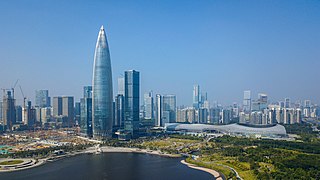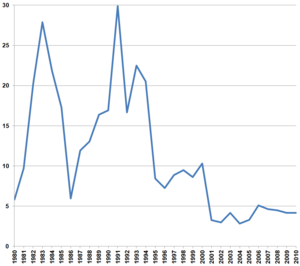
Guangzhou is the capital and largest city of Guangdong province in southern China. Located on the Pearl River about 120 km (75 mi) north-northwest of Hong Kong and 145 km (90 mi) north of Macau, Guangzhou has a history of over 2,200 years and was a major terminus of the Silk Road.

Guangdong is a coastal province located in South China, on the north shore of the South China Sea. The provincial capital is Guangzhou. With a population of 126.84 million across a total area of about 179,800 km2 (69,400 sq mi), Guangdong is the most populous province of China and the 15th-largest by area as well as the third-most populous country subdivision in the world.

Shenzhen is a city and special economic zone on the east bank of the Pearl River estuary on the central coast of the southern Chinese province of Guangdong, bordering Hong Kong to the south, Dongguan to the north, and Huizhou to the northeast. With a population of 17.56 million in 2020, Shenzhen is the third most populous city by urban population in China after Shanghai and Beijing. Shenzhen is a global center in technology, research, manufacturing, business and economics, finance, tourism and transportation, and the Port of Shenzhen is the world's fourth busiest container port.
The culture of Hong Kong is primarily a mix of Chinese and Western influences, stemming from Lingnan Cantonese roots and later fusing with British culture due to British colonialism. As an international financial center dubbed "Asia's World City", contemporary Hong Kong has also absorbed many international influences from around the world. Moreover, Hong Kong also has indigenous people and ethnic minorities from South and Southeast Asia, whose cultures all play integral parts in modern-day Hong Kong culture. As a result, after the 1997 transfer of sovereignty to the People's Republic of China, Hong Kong has continued to develop a unique identity under the rubric of One Country, Two Systems.

Luohu District is a district of Shenzhen, China, located north of the New Territories of Hong Kong, east of Futian District, southeast of Longgang District, southwest of Pingshan District, and west of Yantian District. It is one of the oldest parts of the city, having represented Shenzhen as a fishing village before 1953 and a market town from 1953 to 1979, when Bao'an County was promoted to a prefecture-level city and renamed Shenzhen.

Cantonese is a language within the Chinese (Sinitic) branch of the Sino-Tibetan languages originating from the city of Guangzhou and its surrounding Pearl River Delta. It is the traditional prestige variety of the Yue Chinese group, which has over 82.4 million native speakers. While the term Cantonese specifically refers to the prestige variety, it is often used to refer to the entire Yue subgroup of Chinese, including related but partially mutually intelligible varieties like Taishanese.
The Han Chinese people can be defined into subgroups based on linguistic, cultural, ethnic, genetic, and regional features. The terminology used in Mandarin to describe the groups is: "minxi", used in mainland China or "zuqun", used in Taiwan. No Han subgroup is recognized as one of People's Republic of China's 56 official ethnic groups, in Taiwan only three subgroups, Hoklo, Hakka and Waishengren are recognized.

Lufeng, alternately romanized as Lukfung in Cantonese, is a county-level city in the southeast of Guangdong province, administered as a part of the prefecture-level city of Shanwei. It lies on the mainland on coast of the South China Sea east of Hong Kong.

Shatoujiao is a subdistrict of Yantian District, Shenzhen, Guangdong, located on the border of Shenzhen and Hong Kong, China. The population is mainly composed of migrant workers from all parts of China along with a small number of Russians. Shatoujiao is a port with cargo coming into and exiting Yantian. It has a road connecting to Luohu, with regular bus services to Shenzhen's main train terminus and through connections to Guangzhou. The subdistrict lies near a highway that links to Meixian and Chaozhou while the Shenzhen railway is also part of the transport links between Hong Kong and Beijing.

Bao'an District is one of the nine districts comprising the city of Shenzhen, Guangdong province. It is one of the districts formerly lying outside the Shenzhen Special Economic Zone.

During the British colonial era, English was the sole official language until 1978. Today, the Basic Law of Hong Kong states that English and Chinese are the two official languages of Hong Kong. All roads and government signs are bilingual, and both languages are used in academia, business and the courts, as well as in most government materials today.
The Weitou dialect is a dialect of Yue Chinese. It forms part of the Guan–Bao branch of Yuehai. It is spoken by older generations in Luohu and Futian districts in Shenzhen, and by those in the New Territories, Hong Kong.

Nanshan District is one of the nine districts comprising Shenzhen. It encompasses the southwest area of the Shenzhen Special Economic Zone, with a population of 1.08 million. In 2022, the district of Nanshan's local GDP output exceeded 800 billion Chinese Yuan or 111 billion U.S. dollars, an economy slightly larger than that of Cuba or Oman. The region has an established tourism industry and is home to several sightseeing locations, as well as multiple seaside parks such as the Shenzhen Bay Park and the Shenzhen Talent Park. Its tallest building is the 393-meter China Resources Headquarters.

Bao'an County, formerly named Xin'an County, was a historical county in South China. It roughly follows the administrative boundaries of modern-day Hong Kong and the city of Shenzhen. For most of its history, the administrative center of the county was in Nantou.

Wutong Mountain (Chinese: 梧桐山; pinyin: Wútóng Shān; Jyutping: Ng4tung4 saan1; Hong Kong Hakka: Ng2tung2san1) is a mountain located near the border of Luohu and Yantian in Shenzhen, China. At 943.7m, it is the tallest mountain in Shenzhen. The mountain is also source of the Shenzhen River.
Hongkongers, Hong Kongers, Hong Kongese, Hongkongese, Hong Kong citizens and Hong Kong people are demonyms that refer to the resident of Hong Kong, although they may also refer to others who were born and/or raised in the territory.

Yongxin County is a county in the west of Jiangxi province, People's Republic of China, bordering Hunan province to the west. It is located within the Jinggang Mountains under the jurisdiction of the prefecture-level city of Ji'an. The county was built in the ninth year of Jian'an in the Eastern Han dynasty that is, in 204 AD. The name of the county was derived from Great Learning in the meaning of "the sun (日) is forever (永) and the moon (月) is new (新)".
Regional discrimination in China or regionalism is overt prejudice against people based on their places of origin, ethnicity, sub-ethnicity, language, dialect, or their current provincial zones. China's sheer size and population renders much demographic understanding tied to locality, and there is often little life movement outside of a citizen's province of birth. Historically, internal migration has been tightly controlled, and many barriers to free movement exist today. Treatment of ethnic minorities and Han Chinese regional groups can hinge on preferential assumptions based on places of upbringing, and is often most pronounced towards those born external to urban zones.

Shenzhen has an extensive transport network, including various forms of land, water and air transport.
In 2009, there were 974 preschool educational institutions in Shenzhen, a city in Guangdong, China: 346 elementary schools with 589,500 students, 285 primary and secondary schools with 316,000 students, and 20 secondary vocational schools with 47,000 students. There were also nine full-time higher education institutions based in the city, one higher education institution with correspondence education and 109 higher education institution branches. In total, 67,000 students studied at Shenzhen universities.















